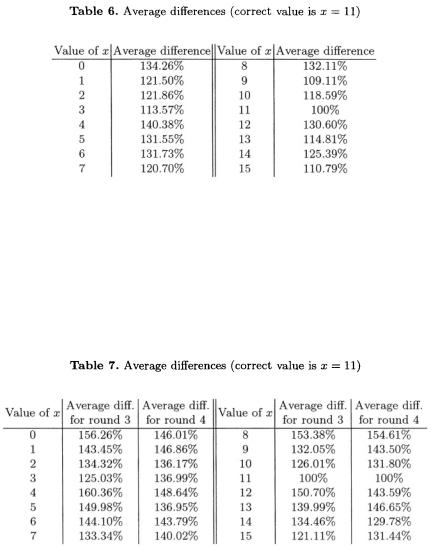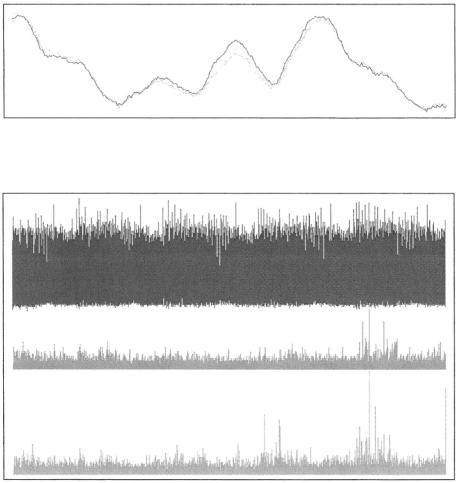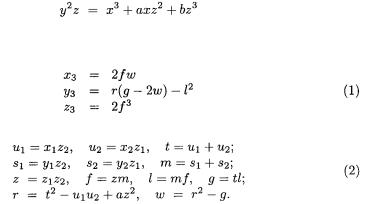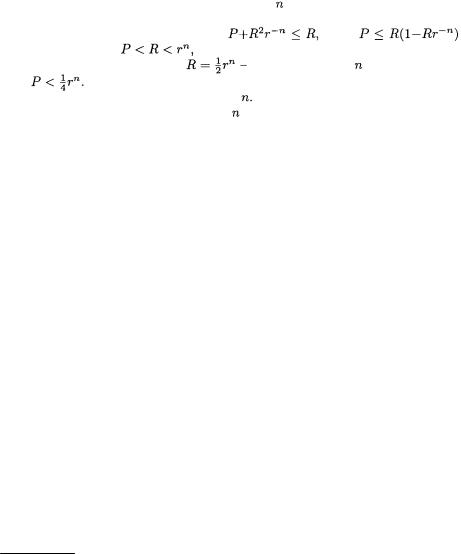
Joye M.Cryptographic hardware and embedded systems.2005
.pdf
186 H. Ledig, F. Muller, and F. Valette
4Experimental Results
In order to verify the previous analysis we implemented a CA against DES implemented in software on a smart-card. This smart-card used classical hardware countermeasures :
variable internal clock
electric noise (random peaks of power)
We managed to detect collisions despite these countermeasures. The trickiest part was to get rid of the “random” peaks of power. Fortunately these peaks were not truly random (they were strongly correlated with the external clock) and were eliminated by analyzing several samples for the same encryption (i.e. 5 samples, but even 2 samples could be sufficient in practice). We took into account only the smallest power consumption among these samples, in order to eliminate the peaks of “over-consumption”. After this preliminary work, we applied our analysis to the full power trace of each round (the rounds are very easy to distinguish). More precisely, we were able to identify which portions are really meaningful inside each round (namely where are located the S-box computations, etc ... ) but did not exploit it. Indeed we want to point out that collisions can be detected very simply and very efficiently.
4.1The Attack Setting
In order to actually mount the attack, we need to introduce an appropriate set of plaintexts and detect at least one collision at round 2. As described in Section 1, 8 messages are sufficient to guarantee a collision. However we used here the full set of 32 messages described in Section 2. This simplifies the attack since we can process more data. Concretely our attack algorithm is the following
Guess the value of |
|
|
For each |
identify the 16 pairs of plaintexts that should give a collision. |
|
For each |
pair of plaintexts, compute the difference |
of power con- |
sumption curves 2.
Average these 16 differences.
The correct value of  should yield the smallest average difference. The result obtained for round 2 are summarized in Table 6. The unit of this average value has little significance. Hence we just picked as a reference the minimal value and expressed the others as a ratio regarding this minimum.
should yield the smallest average difference. The result obtained for round 2 are summarized in Table 6. The unit of this average value has little significance. Hence we just picked as a reference the minimal value and expressed the others as a ratio regarding this minimum.
Actually large portions of the curves are useless for this analysis (for various reasons their power consumption depends little on the arguments) and behave just like noise in practice.
2 Our curves contain of course only a finite number of points corresponding to the electric consumption at instants  The difference of consumption between two curves C and
The difference of consumption between two curves C and is by convention
is by convention
TEAM LinG

Enhancing Collision Attacks |
187 |
4.2Using Almost Collisions
In this section we implement the attack based on almost collision. Thus we analyze power consumption curves at rounds 3 and 4. After a collision at round 2, these curves remain quite similar, as predicted. This yields excellent results in Table 7, even better than those obtained with round 2. It comforts the assumption that almost collisions can be used as an efficient indicator.
To illustrate this attack, we represented a significant portion of round 4 for 3 plaintexts, among which 2 correspond to an almost collision (see Figure 3). The 2 corresponding curves are in average closer to each other than the third one. However some portions (like the right half of Figure 3) are more significant than the others (the left part of Figure 3 is very noisy).
At a larger scale, it is funny to notice that the useful portions of curves are positioned differently depending on the significant indicator. For instance the best indicator at round 3 is the number of active S-boxes (see Table 4) while, at round 4, the best indicator is the number of active bits. Our experiments have
TEAM LinG

188 H. Ledig, F. Muller, and F. Valette
Fig. 3. Three curves corresponding to round 4
Fig. 4. The whole power consumption curves (round 1 to 4) and the corresponding differences
shown that these indicators reflect to different portions of each round (roughly, the beginning of round for active bits and the end of round for active S-boxes).
We have represented in Figure 4, the whole computation for the same plaintexts than those of Figure 3. In addition to the power consumption curves (represented on top but they are not very speaking), we represented a “wrong” difference (in the middle) and the “good” difference (at the bottom). This “good” difference corresponds to the almost collision. One observes that the average value of theses two additional curves increases along the computation. This is simply due to the diffusion of the input difference. Besides, the “good” differ-
TEAM LinG
Enhancing Collision Attacks |
189 |
ence curve has larger peaks than the “wrong” one, especially for rounds 3 and 4. Hence these rounds prove to be better indicators of a collision than the round
2itself.
4.3Summary
We have demonstrated that a thin analysis of the smart-card behavior at rounds 3 and 4 can lead to improved attacks, even when really few messages are available or a large amount of background noise. The remarkable thing with such attacks is that the curves for each round have been handled as a whole. Nevertheless an important bias (resulting from a collision at round 2) can be observed experimentally.
Therefore countermeasures limited to a local protection are unlikely to work against such “large-scale” attacks. Besides protecting only the first or second round with ad-hoc countermeasures is not sufficient. CA may exploit information up to round 4 or 5 depending on the diffusion speed. Countermeasures should modify the execution deeply. For instance, methods based on splitting or masking are the most likely to protect against CA. However their resistance against advanced versions of CA should be further investigated.
5Conclusion
We described new methods for enhancing collision attacks. First we proposed a generic collision attack against Feistel ciphers which requires fewer messages than previous results and can be applied in many cases. Secondly, we suggested to improve collision attacks by considering several rounds of encryption instead of restricting the analysis to the first two rounds (as it is done by most side channel attacks). Indeed we showed that almost collisions - i.e. abnormally similar internal states - may appear in the collision attack scenario. They furnish better indicators than those used by previous attacks. Our experiments against DES implemented on a smart-card confirm our theoretical analysis.
Acknowledgments. We would like to thank Andreas Wiemers for some helpful discussions. We also thank Rémy Daudigny and the members of the LSC laboratory for helping us in the experimental work and capturing the power traces.
References
1.K. Aoki, T. Ichikawa, M. Kanda, M. Matsui, S. Moriai, J. Nakajima, and T. Tokita. Camellia: A 128-Bit Block Cipher Suitable for Multiple Platforms - Design and Analysis. In E. Tavares, editor, Selected Areas in Cryptography – 2000, volume 2012 of Lectures Notes in Computer Science, pages 39–56. Springer, 2001.
TEAM LinG
190 H. Ledig, F. Muller, and F. Valette
2.E. Biham and A. Shamir. Differential Cryptanalysis of DES-like Cryptosystems. In A. Menezes and S. Vanstone, editors, Advances in Cryptology – Crypto’90, volume 537 of Lectures Notes in Computer Science, pages 2–21. Springer, 1990.
3.E. Biham and A. Shamir. Differential Fault Analysis of Secret Key Cryptosystems. In B. Kaliski, editor, Advances in Cryptology – Crypto’97, volume 1294 of Lectures Notes in Computer Science, pages 513–525. Springer, 1997.
4.D. Boneh, R. DeMillo, and R. Lipton. On the Importance of Checking Cryptographic Protocols for Faults (Extended Abstract). In W. Fumy, editor, Advances in Cryptology – Eurocrypt’97, volume 1233 of Lectures Notes in Computer Science, pages 37–51. Springer, 1997.
5.P-A. Fouque and F. Valette. The Doubling Attack – Why Upwards is Better than Downwards. In C. Walter, Ç. Koç, and C. Paar, editors, Cryptographic Hardware and Embedded Systems (CHES) – 2003, volume 2779 of Lectures Notes in Computer Science, pages 269–280. Springer, 2003.
6.P. Kocher. Timing Attacks on Implementations of Diffie-Hellman, RSA, DSS, and Others Systems. In N. Koblitz, editor, Advances in Cryptology – Crypto’96, volume 1109 of Lectures Notes in Computer Science, pages 104–113. Springer, 1996.
7.P. Kocher, J. Jaffe, and B. Jun. Differential Power Analysis. In M. Wiener, editor,
Advances in Cryptology – Crypto’99, volume 1666 of Lectures Notes in Computer Science, pages 388–397. Springer, 1999.
8.M. Matsui. New Block Encryption Algorithm MISTY. In E. Biham, editor, Fast Software Encryption – 1997, volume 1267 of Lectures Notes in Computer Science, pages 54–68. Springer, 1997.
9.T. Messerges. Using Second-Order Power Analysis to Attack DPA Resistant software. In Ç. Koç and C. Paar, editors, Cryptographic Hardware and Embedded Systems (CHES) – 2000, volume 1965 of Lectures Notes in Computer Science, pages 238–251. Springer, 2000.
10.NIST FIPS PUB 46-3. Data Encryption Standard, 1977.
11.K. Schramm, G. Leander, P. Felke, and C. Paar. A Collision-Attack on AES Combining Side Channel And Differential-Attack. 2003. Submitted for Publication.
12.K. Schramm, T. Wollinger, and C. Paar. A New Class of Collision Attacks and its Application to DES. In T. Johansson, editor, Fast Software Encryption – 2003, volume 2887 of Lectures Notes in Computer Science. Springer, 2003.
13.A. Wiemers. Partial collision search by side channel analysis, 2003. Presentation at the Workshop : Smartcards and Side Channel Attacks.
TEAM LinG
Simple Power Analysis of Unified Code for ECC Double and Add
Colin D. Walter
Comodo Research Laboratory
10 Hey Street, Bradford, BD7 1DQ, UK
Colin.Walter@comodogroup.com
Abstract. Classical formulae for point additions and point doublings on elliptic curves differ. This can make a side channel attack possible on a single ECC point multiplication by using simple power analysis (SPA) to observe the different times for the component point operations. Under the usual binary exponentiation algorithm, the deduced presence or absence of a point addition indicates a 1 or 0 respectively in the secret key, thus revealing the key in its entirety.
Several authors have produced unified code for these operations in order to avoid this weakness. Although timing differences are thereby eliminated from this code level, it is shown that SPA attacks may still be possible on selected single point multiplications if there is sufficient side channel leakage at lower levels. Here a conditional subtraction in Montgomery modular multiplication (MMM) is assumed to give such leakage, but other modular multipliers may be equally susceptible to attack.
The techniques are applicable to a single decryption or signature even under prior blinding of both the input text and the secret key. This means that one should use a constant time implementation of MMM even if the secret key is blinded or replaced every time, and all side channel leakage should be minimised, whatever multiplier is used.
Keywords: Side channel leakage, simple power analysis, SPA, elliptic curve cryptography, ECC, unified code, Montgomery modular multiplication.
“To ensure that the data carrier consumes the same amount of current whether the requested operation is authorized or unauthorized, a bit is stored in the memory in either event.” [Abstract, US Patent 4211919, “Portable data carrier including a microprocessor”, filed 28 Aug 1978.]
“No one sews a patch of unshrunk cloth on an old garment, for the patch will pull away from the garment, making the tear worse.” [Matt 9:16, The Bible (New International Version)]
1Introduction
Side channel leakage of secret key information from cryptographic devices has been known publicly for a number of years [1]. In elliptic curve cryptography
M. Joye and J.-J. Quisquater (Eds.): CHES 2004, LNCS 3156, pp. 191–204, 2004. |
|
© International Association for Cryptologic Research 2004 |
TEAM LinG |

192 C.D. Walter
(ECC) [9,13], techniques to reduce this leakage include the use of unified code for point additions and point doublings [3,7,8,12]. When properly implemented, this should eliminate the ability to distinguish the two operations by timing measurements on an appropriate side channel such as power variation [10,11].
However, for a point doubling some of the arguments are inevitably repeated unless extra precautions are taken. This means that doublings might be separated from additions simply by observing when identical operands, identical arithmetic computations, or identical results are likely to have occurred1. This might be done using timing, current or EMR variation [4,5,6,10,11,15]. The generality of such an attack shows that it may be unwise to attempt to patch up old (i.e. leaky) hardware using new, leak-resistant software counter-measures.
Here, to make the details concrete and quantifiable, this is considered for a specific choice of the algorithms and form of side channel leakage, namely: i) point multiplication using the standard square-and-multiply exponentiation algorithm, together with ii) the version of unified code presented by Brier and Joye [3] and their suggested implementation, iii) field multiplication using a version of Montgomery modular multiplication (MMM) [14] which includes a conditional subtraction and iv) a cryptographic device in which every such subtraction can be observed on some side channel or combination of side channels. It is shown that this association leaks sufficiently for it to be computationally possible to deduce some keys for standard elliptic curves over the smaller fields even if they are used just once. The choice of Montgomery, while perhaps not natural for the EC-DSA prime fields, has the benefit of being very well studied, so that the required probabilities are known. Almost any other leaky modular multiplier could be substituted.
One of the standard, recommended, EC-DSA elliptic curves is chosen for illustration, namely P-192 [2]. Some theoretical analysis shows that there are some input texts which are weaker than average in terms of the number of additions which can be positively identified as not being doublings. Increasing the sample size yields still weaker cases. Experimental results confirm the theory very strongly, showing indeed that there are even weaker instances where the secret key can be recovered without significant computational resources.
The discussion overturns several potential misconceptions. First, unified code on its own is not a panacea against simple power analysis. It protects only one aspect of the implementation. Secondly, the three standard blinding techniques helpfully listed by Coron [4] can provide no protection at all gainst some attacks. And thirdly, modular multiplication can leak sufficient data for a successful attack even when a key is used just once, such as in the Digital Signature Algorithm (DSA) [2]. Previously, MMM was only known to leak so severely if the same, unblinded key was used repeatedly.
In conclusion, even with modern leak-resistant algorithms, field multiplication should clearly be implemented in a time independent manner and, indeed,
1 For example, for both the redundant-operation-enhanced formulae of [7] and the Hessian form in [8], doubling reveals itself if field squares can be detected. Further, the Jacobi form in [12] suffers from essentially the same potential weakness as is explored here for the Weierstraß form in [3], namely repeated evaluation of identical field products.
TEAM LinG

Simple Power Analysis of Unified Code |
193 |
although the case is not detailed here, in a manner which has a low probability of emitting enough side channel leakage to distinguish successfully between identical and non-identical pairs of multiplications.
2The Unified Point Addition/Doubling Formula of Brier and Joye
Brier and Joye [3] provide formulae which unify the classical formulae for point addition and point doubling on the Weierstraß form of an elliptic curve. They describe a number of cases, including the use of either affine or projective coordinates.
In their point addition formula for affine coordinates, there is no longer a denominator which becomes zero for point doubling. So a separate formula is not needed. Although there is still a denominator which may be zero, this special case is no longer associated with point doubling, but with the sum being the exceptional point  at infinity. So the formula breaks the previously strong connection between bit values of the secret key and sub-sequences of arithmetic operations.
at infinity. So the formula breaks the previously strong connection between bit values of the secret key and sub-sequences of arithmetic operations.
Assume projective coordinates are used for the representation of points 
 on the Weierstraß form of an elliptic curve
on the Weierstraß form of an elliptic curve
where the field characteristic is not 2 or 3. Then, for points 
 the point addition
the point addition  is achieved by Brier and Joye using:
is achieved by Brier and Joye using:
where
This involves eighteen field multiplications, of which one is by the constant  five are in the equations (1) and thirteen in the equations (2). Without loss of generality, it is assumed that the implementation under attack computes the coordinates of
five are in the equations (1) and thirteen in the equations (2). Without loss of generality, it is assumed that the implementation under attack computes the coordinates of  by taking each of these last equations (2) and calculating the right sides in the order presented before calculating those for (1).
by taking each of these last equations (2) and calculating the right sides in the order presented before calculating those for (1).
3The Point Multiplication Algorithm
We assume point multiplication is done using the standard square-and-multiply (or double-and-add) exponentiation method of Fig. 1. There are two main properties of this algorithm which are used here. First, each bit 1 in the key generates a point doubling followed by a point addition, but a bit 0 in the key generates a
TEAM LinG

194 C.D. Walter
Fig. 1. Left-to-Right Binary “Double-and-Add” Algorithm.
point doubling which is followed by another point doubling. Hence, it is easy to translate from a sequence of adds and doubles obtained through a side channel into a sequence of bits which reveals the secret key. Secondly, the initial input P is an argument in every point addition. Although this may save some data manipulation, it occasionally produces the bias in each point addition which is exploited here. Choosing instead the right-to-left version of binary exponentiation or  exponentiation
exponentiation  would probably render the attack here computationally infeasible.
would probably render the attack here computationally infeasible.
4Notation and Montgomery Multiplication
For simplicity, we assume the main side channel leakage is from an implementation of field multiplication using Montgomery Modular Multiplication (MMM) [14] in which there is an observable, final, conditional subtraction. However, it must be emphasised that this choice is only for convenience in evaluating the probabilities. A similar attack could be mounted against any modular multiplier exhibiting data-dependent side-channel leakage.
Suppose the elliptic curve is defined over the Galois field 
 and elements of this prime field are represented as long integers modulo P written to base
and elements of this prime field are represented as long integers modulo P written to base  with digits in lowercase. Thus, for example,
with digits in lowercase. Thus, for example, 
 Suppose is the upper bound we wish to have on the inputs and outputs for MMM. Then we assume the version of MMM given in Fig. 2.
Suppose is the upper bound we wish to have on the inputs and outputs for MMM. Then we assume the version of MMM given in Fig. 2.
Fig. 2. Montgomery’s Modular Multiplication Algorithm (MMM). TEAM LinG

Simple Power Analysis of Unified Code |
195 |
The invariant after the loop is easy to establish, and, if desired, the digits  could be formed into a quotient Q giving the multiple of P which has been subtracted. The post-condition C < R then holds providing
could be formed into a quotient Q giving the multiple of P which has been subtracted. The post-condition C < R then holds providing  and R satisfy the right properties, namely that the maximum possible value for C is less than R+P, i.e.
and R satisfy the right properties, namely that the maximum possible value for C is less than R+P, i.e.  which is just the stated pre-condition
which is just the stated pre-condition  This post-condition enables output from one execution of MMM to be fed into another instance of it.
This post-condition enables output from one execution of MMM to be fed into another instance of it.
The usual values for R to take are  or P. The former gives a cheap test
or P. The former gives a cheap test
in the conditional statement, whereas the latter yields the least non-negative |
|
residue as output. Decreasing R or increasing |
reduces the frequency of the |
final subtraction and so reduces the leakage from the timing side channel. In |
|
fact, the subtraction ceases to occur if |
i.e. if |
||
[18]. As this requires |
we would take R as a power of 2 to make the |
||
condition easy to evaluate – say |
|
and demand that be large enough |
|
– say |
Indeed, this choice for R permits the maximum possible value of |
||
P to give no final subtraction for a given |
Hence, for a given maximum value |
||
of P, it is possible to deduce values for |
and R which will always prevent the |
||
final subtraction occurring.
Where side channel attacks are possible, the final, conditional subtraction should be protected from timing variation by performing the subtraction in all cases if it can occur at all and then selecting the new or old value of C as appropriate. Eliminating the need for the final subtraction may lead to less side channel leakage, but an extra loop iteration may be the result of choosing  sufficiently large for this to happen.
sufficiently large for this to happen.
Because, unlike RSA, the ECC-related equations (2) involve field additions or subtractions between some field multiplications, here it is most convenient to take R = P. Then, as noted, the final subtraction will occur occasionally. Observe from the post-loop invariant that its occurrence is independent of the order of inputs. So changing the input order is not a counter-measure to any attack on the final subtraction.
5The Probability of a Conditional Subtraction
To estimate the probability of the extra subtraction of P in MMM, observe that P is large and so one can switch from discrete to continuous methods. For all practical purposes, inputs to MMM are uniformly distributed modulo P. Thus, if the random variable X represents a typical input to MMM, its probability density function  is given by
is given by  on the interval [0, P], and
on the interval [0, P], and  otherwise. Furthermore, outputs are also effectively uniformly distributed modulo P. So the probability of the extra subtraction for random inputs can be deduced from the invariant formula after the loop in MMM [18]. Derivations of this probability are given in [16,17,19] for various contexts2. In the case of squaring X, the probability is
otherwise. Furthermore, outputs are also effectively uniformly distributed modulo P. So the probability of the extra subtraction for random inputs can be deduced from the invariant formula after the loop in MMM [18]. Derivations of this probability are given in [16,17,19] for various contexts2. In the case of squaring X, the probability is  where Z is uniform on [0, P]. Hence
where Z is uniform on [0, P]. Hence
2Taking R equal to a power of 2 leads to some interesting non-uniform distributions which are illustrated graphically in [17].
TEAM LinG
